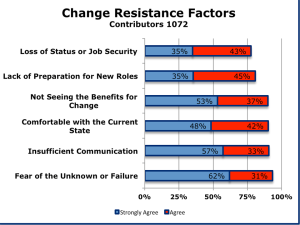Why Do People Resist Change?
Here’s the reality, Leaders need employee support and trust if their change is going to stand any chance of success. Our contributors underscore this. If people are cynical about a change, pessimism will set in, and failure is assured. Our contributors show that there are no simple remedies, no sound bites or grizzly 7 step plans. Yet, at its core there are fundamental values that, if believed in, will offer a sound basis for planning and executing successful change. Change failures have left their mark on our contributors over the last eight years. Through their eyes, resistance is a brownfield site [2] where change is synonymous with downsizing, doing more for less, and treating people poorly.
Accelerated change demands more of everyone. Such change has major consequences for employees. Accelerated change failure creates cultural toxicity. Crucially, leaders need to separate the symptoms of change resistance from the stress that causes it. If they don’t, they are just like bad sales people trying to overcome objections and not realizing 60% of those objections are of the salesperson’s own creation. These contributors, they are saying that change resistance is natural, but you don’t need to make it more difficult if you do some things profoundly well. The chart below gives a sense of the avoidable.

Once you recognize that Change Resistance causes stress then you can be more effective in reducing it. Our contributors say that, if leaders create clear and consistent frameworks, you help most people make informed decisions about committing to a change or not. Here’s what our contributors are saying:
- Align Expectations between leaders and people
- Set Clear Direction: Leaders clarify their change’s What, Why, How and WIIFMs (What’s In It For Me) for different groups and people.
- Develop Accountabilities: by developing the rewards and consequences that assure expectations of both leaders and their people are met.
These are sound practices for reducing and managing people’s stress, but only if leaders realize the importance of Walking Their Own Talk.
Action Points: Managing Change Stress and Resistance
All these contributors are saying that change resistance is natural, but you don’t need to make it that difficult if you do some things profoundly well.
This starts with recognizing that change resistance is caused by stress. So why not treat the cause and not the symptom? Stress is natural and good if managed. Stress is reduced if leaders create clear and consistent frameworks that help people make informed decisions about committing to a change or not. Here’s how we interpret what our contributors are saying
Clarifying the Direction:
Leaders clarify their change’s what, why, how, and WIIFMs¹ for different groups and individuals. What does this mean for me? This leads to aligning expectations.
Aligning Expectations:
This is a process flow in two directions between leaders and each individual.
Developing Accountabilities:
This step develops the rewards and consequences through performance measurement, management, and rewards that ensure expectations of both leaders and their people are met.
To read all the findings go to the section – Why do people resist change in Focusing Change To Win
![]()
![]()
